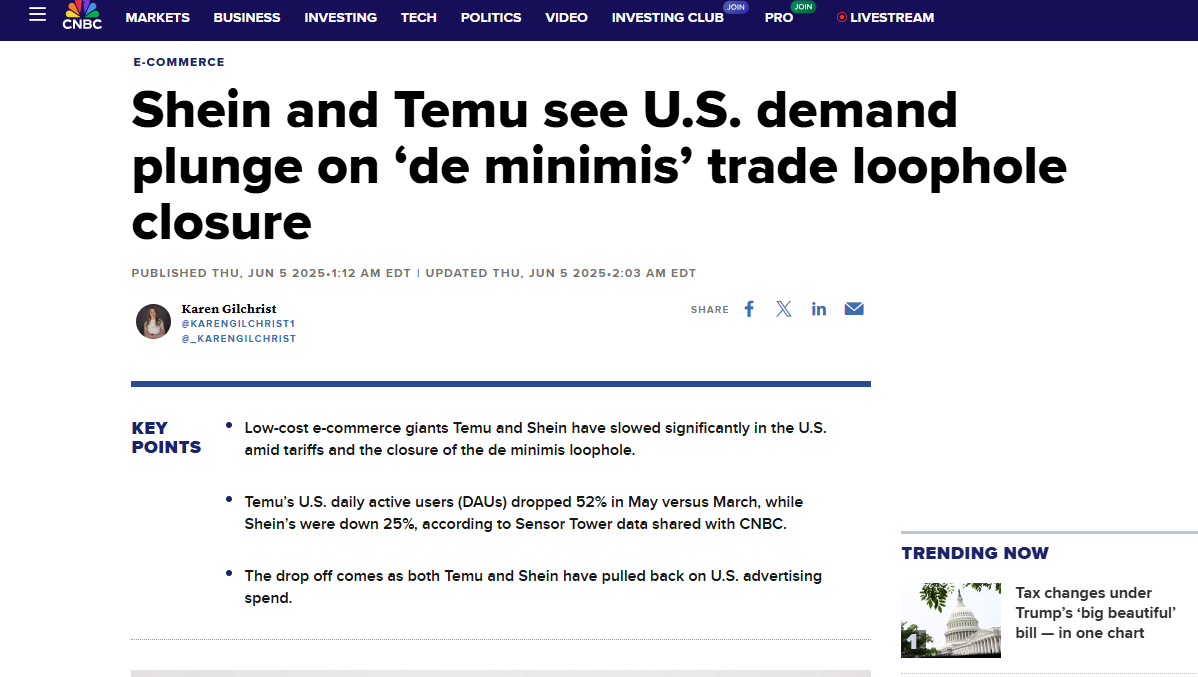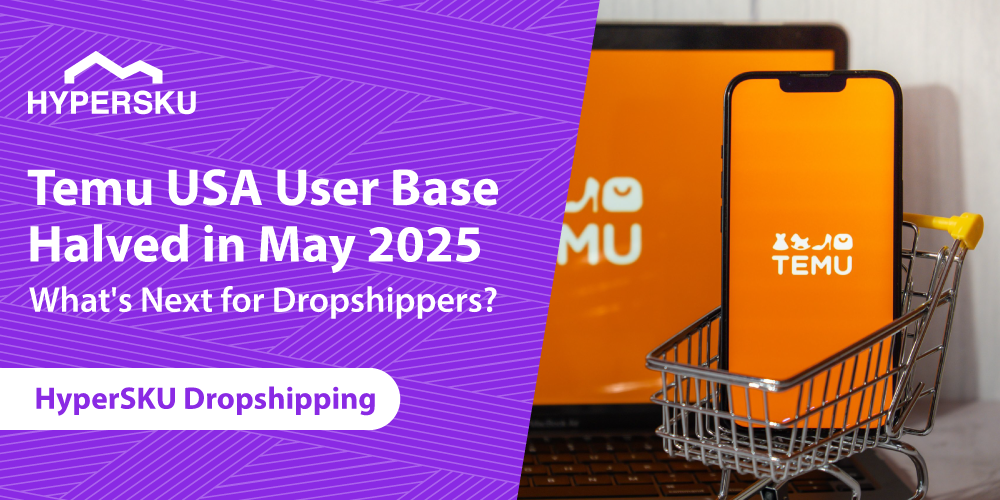Temu USA’s Sudden 52% User Drop: What’s Behind the Sharp Decline?
Temu was once a major disruptor in the U.S. eCommerce market, attracting millions of shoppers with unbeatable deals and free shipping. But in 2025, the platform faced a sharp drop in user activity that caught many by surprise.
But by mid-2025, that momentum has started to fade.
According to Sensor Tower data shared via CNBC, Temu’s U.S. daily active users dropped 52% in May compared to March. The decline comes amid rising political pressure to eliminate the “de minimis” loophole—a trade rule that allowed low-value imports (under $800) to enter the U.S. duty-free and with minimal customs oversight.

As Temu cuts back on advertising and faces growing scrutiny over its logistics and compliance, uncertainty rises—especially for sellers who rely on the platform. Yet amid the disruption lies opportunity. With less noise from platform-driven promotions and shifting buyer expectations, independent merchants have a chance to regain trust, speed, and transparency.
In this article, we explore how the Temu USA downturn is reshaping eCommerce—and how agile sellers can adapt. We’ll also show how HyperSKU helps merchants stay competitive with flexible sourcing, fast fulfillment, and localized strategies.
Quick Takeaways
-
Temu’s U.S. user base dropped by 52% in May 2025 (Sensor Tower via CNBC)
-
Lawmakers are targeting the “de minimis” loophole, raising costs for Chinese eCom platforms
-
Temu has reduced Meta ads, hidden listings from China, and faces declining consumer trust
-
U.S. sellers now have a window to win back market share through speed, transparency, and local fulfillment
-
Brands must adapt logistics, diversify sourcing, and focus on long-term trust over short-term pricing
What Is the De Minimis Rule—And Why It Matters Now
One of the core reasons platforms like Temu have been able to offer such low prices in the U.S. is a little-known trade rule: the de minimis threshold.
In short, this rule allows imports valued under $800 to enter the U.S. without duties or detailed customs checks. Originally intended to reduce administrative burdens for low-value parcels, it wasn’t built for today’s high-volume eCommerce giants.
However, platforms like Temu and SHEIN built their models around it—shipping millions of low-cost parcels directly to U.S. consumers, tax-free.
Critics now call this the “de minimis loophole.” It gives foreign sellers an unfair edge and raises concerns about product safety, labor standards, and transparency.
In 2025, the rule is firmly in the political spotlight. Lawmakers from both parties are pushing for reform, aiming to protect domestic retailers and restore trade balance. Headlines like “Trump tariffs target loophole used by Chinese online retailers” highlight the urgency.
As the rules tighten, platforms like Temu will face higher compliance costs, longer shipping times, and fundamental changes to their U.S. operations.
How the De Minimis Loophole Crackdown Affects Temu’s Operations in the U.S.
The U.S. government’s renewed focus on the de minimis loophole is forcing significant changes in how Temu USA operates. What began as a political debate has quickly turned into tangible disruptions for the platform—impacting everything from product visibility to advertising and consumer trust.
Temu Blocks U.S. Shoppers From Seeing Products Shipped From China
One of the most immediate effects of the crackdown has been a dramatic shift in how Temu displays its product listings. As reported by WIRED, Temu recently began blocking U.S. users from viewing items that ship directly from China, signaling a transition toward relying more on local warehouses. This shift is widely seen as a response to pressure from U.S. Customs and the risk of delays or tariffs under the new trade scrutiny.
While this may streamline compliance, it fundamentally alters Temu’s operational model and may limit the breadth of products available to American shoppers.
Temu Pulls Back on U.S. Meta Advertising
As part of a broader slowdown, Temu has cut back its advertising spending on platforms like Facebook and Instagram, according to CNBC. The company’s U.S. app store rankings have also slipped, suggesting reduced user acquisition and retention.
This pullback reflects growing uncertainty around profitability in the U.S. market and raises questions about how Temu will continue to grow amid regulatory headwinds.
Rising Operating Costs and Supply Chain Stress
Temu’s original advantage came from shipping low-cost goods directly to consumers without duties, thanks to the de minimis loophole. Now, with increased inspections and the potential for new tariff applications, Temu faces higher fulfillment costs, warehousing fees, and compliance risks.
If stricter rules are passed or enforcement continues to tighten, Temu could see its cost structure fundamentally shift, making it harder to maintain its “ultra-low price” brand promise.
Consumer Trust and Declining User Base
Public sentiment toward Temu is also shifting.With growing media coverage of counterfeit products, privacy issues, and labor practices, the platform is experiencing a trust gap that is becoming harder to repair.
Shoppers are beginning to ask: Is it worth saving a few dollars if the delivery is unreliable or if the product’s origin is unclear?
Impact on Small Businesses and U.S. Sellers
While the crackdown poses challenges for platforms like Temu, it also opens the door for small businesses and U.S.-based sellers to regain competitive ground. For years, American entrepreneurs have struggled to compete with ultra-low prices and duty-free imports from Chinese platforms operating under the de minimis rule.
Now, as enforcement tightens and costs rise for overseas competitors, domestic sellers can differentiate through faster shipping, better quality control, and transparent customer service. The shift may also encourage more consumers to support local or near-shore sellers, especially as trust in ultra-budget platforms continues to erode.
Additionally, this regulatory reset could level the playing field on major marketplaces like Amazon, Etsy, and TikTok Shop, making 2025 a pivotal year for U.S. eCommerce innovation and repositioning.
Why This Crackdown Creates Opportunities for U.S. eCommerce Sellers
While the de minimis crackdown presents serious challenges for platforms like Temu and SHEIN, it may become a turning point for American and global sellers looking to build sustainable eCommerce brands in the U.S. market.
A Leveling of the Playing Field
For years, sellers shipping from within the U.S. have faced a cost disadvantage when competing with platforms like Temu and SHEIN, which avoided tariffs and taxes under the de minimis rule. With this loophole now under intense regulatory pressure, all sellers may soon be subject to the same cost structures, giving U.S.-based businesses a better chance to compete on product quality, customer experience, and brand trust.
Consumers Are Rethinking “Cheapest Wins”
Shoppers are increasingly aware that ultra-low prices often come with trade-offs—slower delivery, inconsistent product quality, and limited customer service. As platforms like Temu begin to lose their shine, consumers are shifting toward sellers that offer reliability, transparency, and locally stored inventory. This presents a prime opportunity for independent brands and DTC stores to win over price-fatigued buyers with speed and service.
More Demand for Domestic and Near-Shore Fulfillment
As delivery delays from China grow more frequent due to customs scrutiny, fast and consistent fulfillment becomes a powerful selling point. U.S. sellers who already use domestic 3PLs or work with near-shore suppliers (in Mexico, Canada, or Southeast Asia) will be well-positioned to capture demand from frustrated cross-border shoppers.
In fact, offering 2–5 day delivery and clear return policies may now be more valuable than undercutting prices.
Better Margins for Branded Sellers
With platforms like Temu pulling back on ad spending and experiencing declining user trust, competition in digital ad spaces is cooling slightly. U.S. sellers may now enjoy lower CPMs and better ROAS on platforms like Facebook, TikTok, and Google—especially if they emphasize product trust, origin transparency, and fast shipping in their messaging.
Brands that build a loyal customer base and optimize for LTV (lifetime value) rather than volume will likely see stronger, more profitable growth in 2025.
Time to Build a Brand, Not Just a Store
Temu and similar platforms have normalized a “lowest-price-wins” culture. But in a post-de minimis world, brands with identity, values, and customer trust will take center stage. For U.S. sellers, this is a chance to shift the narrative—from racing to the bottom, to building long-term businesses.
As the market corrects and regulatory balance is restored, 2025 may prove to be the year independent sellers finally get a fair shot.
How Sellers Can Adapt — and Thrive — in 2025
The de minimis crackdown has created serious operational challenges for platforms like Temu and SHEIN—disrupting their logistics models and advertising strategies across the U.S. However, as explored earlier in this article, the shifting landscape also presents a window of opportunity for independent and mid-sized eCommerce sellers.
That said, this is not the time for complacency.
Even as Temu loses some of its pricing edge, U.S.-China tariff policy continues to evolve, adding new layers of complexity for global sellers. From potential increases in import duties to heightened customs enforcement, sellers must stay informed and agile to avoid margin loss or fulfillment delays.
To survive—and thrive—in this new landscape, here’s how forward-thinking eCommerce brands can take action:
Understand the Policy Shifts (and Stay Updated)
First and foremost, sellers must educate themselves on current and upcoming changes to import duties, customs enforcement, and de minimis regulations. Many sellers are still unaware of how these changes impact cross-border shipments, product pricing, and platform eligibility.
👉 We recommend reading our previous blog: US-China Tariff Agreement: Full Breakdown and What It Means for Your eCommerce Business for an in-depth, seller-friendly explanation of the latest developments.
Diversify Fulfillment and Sourcing Channels
Relying on a single cross-border route—especially one vulnerable to increased customs scrutiny—is no longer sustainable. Sellers should diversify their sourcing and consider near-shore or domestic fulfillment options to maintain speed and reliability.
This is where agile fulfillment solutions make a difference.
HyperSKU, for example, empowers sellers to fulfill orders from China with a faster delivery time. With deep experience navigating cross-border logistics and platform integrations, HyperSKU gives sellers a flexible foundation to adapt.
Reposition Your Brand Around Trust and Transparency
With platforms like Temu losing consumer trust, now is the time for independent sellers to stand out through authenticity and reliability. That means clear shipping times, honest product descriptions, and open communication with buyers.
Leverage New Advertising Gaps
As Chinese platforms reduce their ad spending due to rising costs and political pressure, U.S.-based brands may see lower ad competition on platforms like Meta, TikTok, and Google. Sellers who focus on real value propositions (such as local fulfillment, customer service, and return policies) can optimize ROAS and gain market share in 2025.
Partner with Smart, Scalable Tools
Agility is everything. Whether you’re testing new SKUs or scaling a TikTok Shop, sellers need tools that match their growth. HyperSKU offers:
- Reliable supplier access with vetted quality
- Smart sourcing based on demand trends
- Fast fulfillment from China
- Easy Platform integrations (Shopify, WooCommerce, TikTok Shop, and more)
In short, 2025 is not the end of lean eCommerce—it’s the reinvention of it. With the right partnerships and strategy, sellers can turn regulatory risk into long-term resilience.
Final Thoughts:
Temu’s explosive growth in the U.S. market has shown just how powerful low-cost, cross-border eCommerce can be. But with the de minimis loophole under fire, the current tariff policy remains uncertain and subject to rapid changes, and consumer sentiment shifting, 2025 marks a turning point for global online retail.
For large platforms like Temu and SHEIN, increased scrutiny brings rising costs and shrinking trust. For independent sellers and emerging brands, however, it opens a door.
Now is the time to rethink logistics, strengthen your brand positioning, and prepare for long-term scalability. Whether that means optimizing fulfillment, tapping into more transparent sourcing, or diversifying your sales channels—adaptability is the only sustainable strategy.
If you’re ready to future-proof your eCommerce business, working with a flexible fulfillment partner like HyperSKU can help you stay competitive, compliant, and customer-focused in this new environment.
The disruption is real. So are the opportunities.
What you do next will define your success in the post-de minimis era.
-
HyperSKU is a global e-commerce fulfillment and supply chain solution provider. Our content team shares practical dropshipping insights, industry data, and best practices to help sellers grow their online business.



